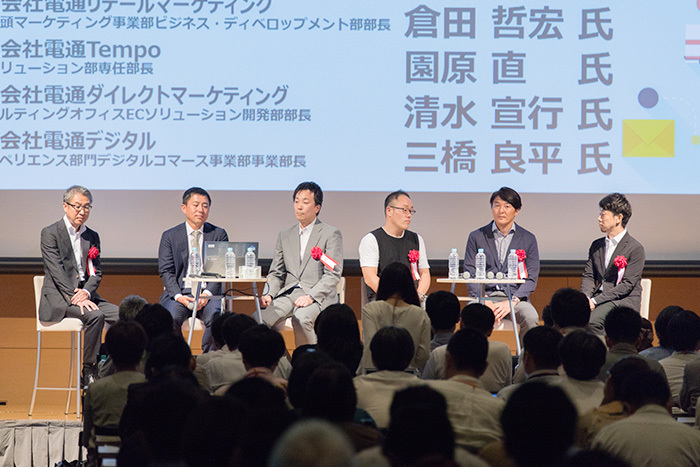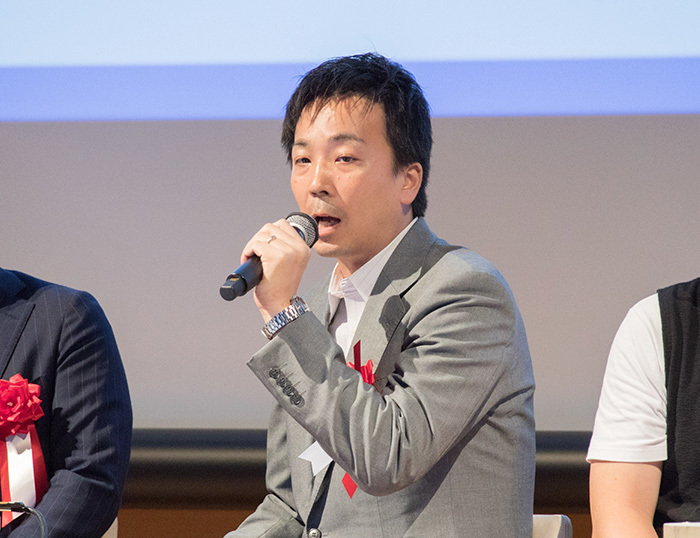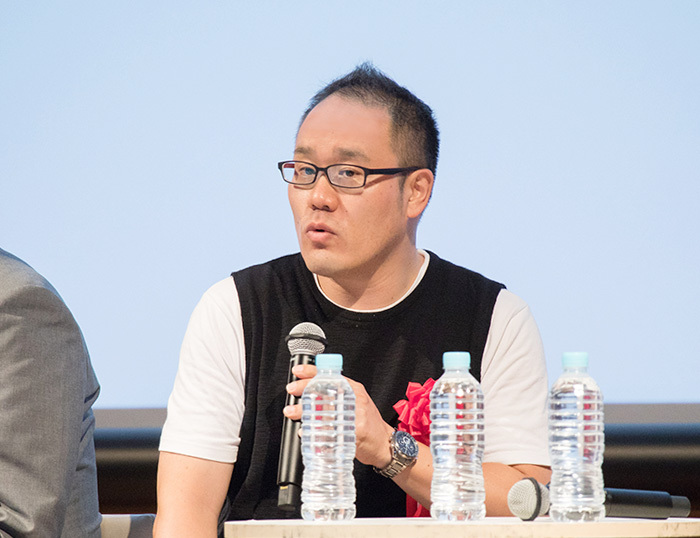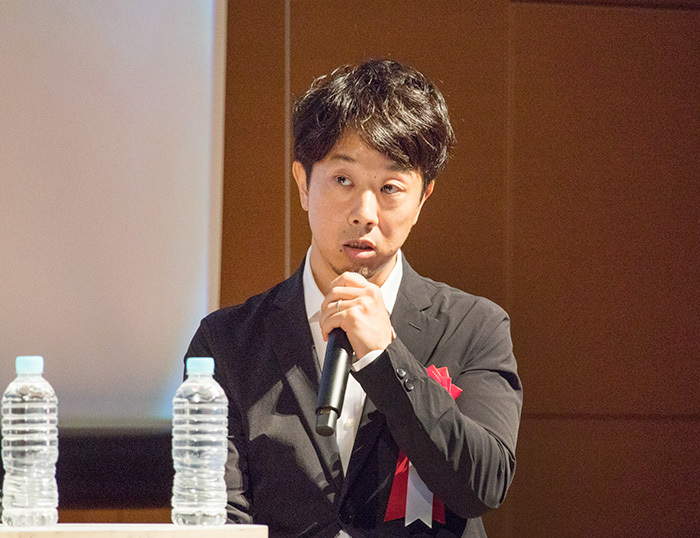"Commerce Marketing Conference—Customer Experience (CX) Transforming Brand Value" was held. Vol.5
On July 29, the "Commerce Marketing Conference—Customer Experience (CX) Transforming Brand Value" was held at Dentsu Inc. Hall. This article covers Part 5, which followed Part 4.
Part 5:
What Are the Solutions from Dentsu Group Companies? Vol. 2


Tetsuhiro Kurata
Mr. Kurata introduced a "digital marketing platform linked to sales floors co-developed with retailers."
"We often hear these challenges regarding digital advertising in physical stores: ① Which creative actually worked? ② Did it drive customers to the store? ③ Did people purchase after seeing the digital ad?" While many companies verify the effectiveness of ad delivery and page views, regarding store visits, we've reached a point where increasing media spend in certain areas can confirm this. However, we believe it remains challenging to verify whether those who saw the ad actually made a purchase. In other words, while e-commerce (around 10% of the market) can verify the path from ad exposure to purchase, physical retail (over 90%) currently cannot verify the purchase itself."
Therefore, Mr. Kurata is building a digital marketing platform. "We've created a system that enables direct ad delivery on ad platforms by receiving member purchase data from partner retailers, using device-based location data, and merging it with cookie data. While limited to our partner retailers, this allows us to provide a digital marketing platform linked to physical store locations. The biggest advantage is the ability to perform precise targeting based on purchase data and to track the entire journey from store visits to purchases and repeat purchases using that data. A key feature is its integration with the sales floor. We've developed this as a solution package that includes actual sales floor deployment, addressing the challenge where increasing ad spend is ineffective if the sales floor isn't properly set up."

Next, Dentsu Tempo's Nao Sonohara presented on the theme "Sales Promotion in the Digital Age: What Flyers Taught Us," explaining the company's solution promotion case studies.
"We developed this solution in response to a request from a nationwide home center chain. They wanted to supplement their insert flyers with web banner ads, specifically animated banners customized per store—changing the creative, product, and price for each location. We met this demand by enabling the replacement of store name, product, and price across all stores. This achieved automated mass production of animated banner ads with store-specific variations while keeping production costs low.
Compared to static images, we saw improved effectiveness in CPM and CPC, with Google's Star Visit metrics increasing by 80.2%. Additionally, banners can be generated directly from flyer drafts. Finalized prices and products are automatically formatted for generation, submission, composition, delivery settings, and in-store visit measurement reporting. Distribution can also be scheduled to align with flyer distribution timelines."
In another case study involving a home improvement store, the request was: "We want to generate landing pages (LPs) for each store that link with the automatically generated web banner ads. They requested content updates aligned with weekly distribution schedules, segmented by demographics. To address this, we developed DLPO (Dynamic Landing Page Optimization), an automated system that generates diverse content from a single template and dynamically replaces elements. Like insert flyers, it simplifies creation from source copy."

Mr. Shimizu introduced the live commerce solution LIVE★X (Live Cross), noting its adoption is expanding beyond celebrities to the general public.
At DENTSU DIRECT INC., we leverage our expertise in infomercial production and social media utilization to build winning live commerce strategies targeting younger audiences," he stated.
He added, "Live commerce has been widespread in China since around 2015, with very high purchase rates. The market size was ¥440 billion (2018), and about half of the internet population (730 million people) has purchased via live commerce. In Japan, while awareness is rising—it was ranked second in Nikkei TRENDY's 2018 Hit Predictions—we still see it as a developing market. Among those aware of it, only 14% have actually purchased, representing 4% of all respondents. However, we're seeing results like celebrities collaborating with viewers to create and sell original sweatshirts, generating 10 million yen in sales." He added, "We analyze that there are many factors driving the expansion of the live commerce market, such as telecommunications carriers launching unlimited video streaming plans and various e-commerce malls implementing live commerce features."

Finally, Mr. Mitsuhashi explained 'E-commerce Branding Undertaken by the Digital Commerce Team'. He stated, "The convergence of web, smartphones, and search environments has created a 'perpetual search society' where people can access desired information whenever they want. This has generated an overwhelming sea of information, leading to a 'natural informationism' where people naturally prioritize information discovered organically, from acquaintances, friends, or third-party media. This significantly influences consumer behavior, ushering in an era where 'consumers lead purchasing' (a consumer-led era)."
Dentsu Digital Inc. then explored what constitutes the ideal experiential value unique to each product or service, and why it matters. "We concluded that E-commerce Branding is crucial," he said. "This involves creating mechanisms that drive sales across online and offline channels—specifically, channel design and experience design, enhancing LTV (brand building), and designing customer experiences (especially for smartphone users) unique to the product or service. This is achieved by leveraging channels like owned e-commerce, platform e-commerce, and physical stores."
The approach consists of three key elements: "First is building and refining entry points and sales spaces. This involves planning to enhance experiential value using SNS and content, building owned e-commerce, and refining sales spaces on platforms like Amazon and Rakuten. Second is approaches targeting existing customers. This includes measures to enhance experiential value by leveraging existing customer touchpoints. We improve e-commerce sites, apps, and develop services to enhance the experiential value for existing customers. Third is the approach to encourage repeat purchases. We implement strategies for repeat purchases using touchpoints with existing customers, approaching them at the optimal touchpoint, message, and timing to foster fan loyalty. We provide branding that combines these three approaches. We create new experiential value, services, brands, and businesses through technology and ideas."
Atsushi Nemoto, General Manager of Dentsu Inc. Commerce Marketing Division 2, stated, "We have established a framework to support the design of the entire customer experience, from awareness to purchase and beyond, leveraging resources from our group companies," indicating a policy of focusing on commerce marketing initiatives.
The final installment next time will cover Part 6, titled "Why Brand Marketers Are Focusing on Commerce Now."
Was this article helpful?